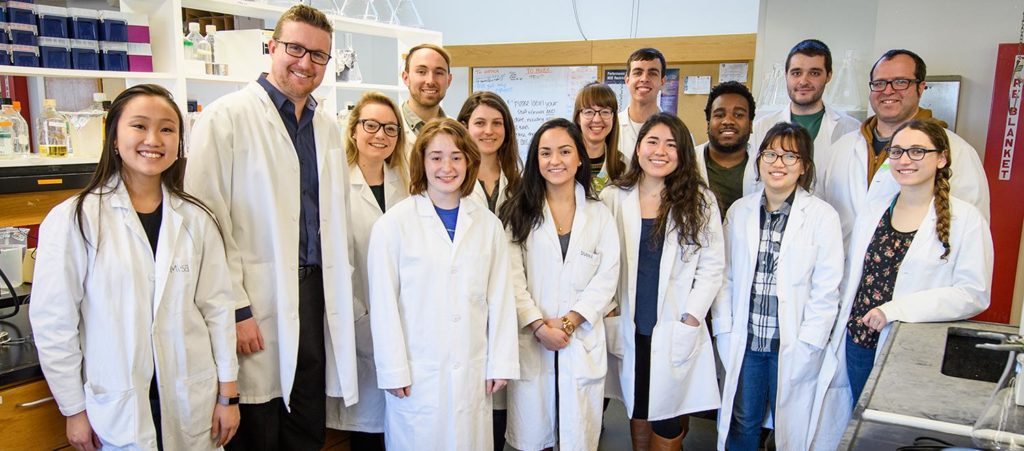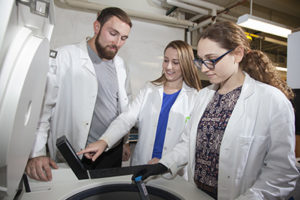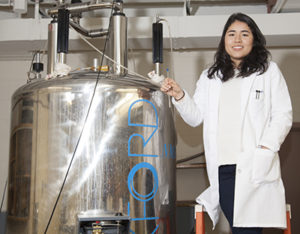$450,000 NIH grant funds Clark protein research

What do autism spectrum disorder, Huntington’s disease, breast cancer, HIV, flu virus, Ebola and male infertility have in common? They are among the many medical issues linked to the biochemical dysfunction of proteins within the human body controlled by another protein, ubiquitin.
For more than a decade, Donald Spratt, a protein chemist and structural biologist, has studied ubiquitin, a protein that regulates almost every biochemical pathway in the human body. Specifically, his research team is studying a unique family of enzymes, the HECT E3 ubiquitin ligases, which are responsible for attaching ubiquitin to other proteins to initiate a cellular response.

Enzymes are proteins that carry a catalytic function and play an important role in the health of humans and other multicellular organisms. They induce the necessary turnover of other proteins during apoptosis, or programmed cell death. This biochemical process is necessary to rid organisms of harmful or excessive cells. Enzymes also are involved in proper signaling pathways within cells.
A $450,000 three-year grant from the U.S. National Institutes of Health (NIH) is allowing Spratt and his research team to dive even deeper into ubiquitin’s structure and biochemical processes by investigating how the HECT E3 ubiquitin ligases work.
“There are 28 distinct HECT E3 ubiquitin ligases in humans with each linked to a different disease or important biological process. We need to understand how proteins that are so similar have such different biological functions in the cell. Understanding how they work will help us learn how and why these different diseases occur,” says Spratt, who joined Clark in 2015 as assistant professor of chemistry and biochemistry and Carl J. and Anna Carlson Endowed Chair in Chemistry.
Proteins are composed of amino acids linked together in a chain and folded into a three-dimensional shape. “The 3D structure of a protein leads to its biological function,” Spratt explains. “Many human diseases are caused when a protein or enzyme is mutated or misfolded. By learning more about the structure and function of members of the HECT E3 ubiquitin ligase family, we hope to clarify how and why the malfunction of these proteins cause disease.”
“All of the HECT E3 ubiquitin ligases that we study in our lab are responsible for attaching ubiquitin to another protein in the cell,” Spratt says. Scientists have called ubiquitin the “molecular kiss of death”because it marks proteins for destruction.
But how can scientists peer into this biochemical activity to study it?
Spratt’s lab uses 2D and 3D nuclear magnetic resonance (NMR) spectroscopy — the scientific lab version of a hospital’s MRI machine — to investigate the catalytic mechanism of HECT E3 ubiquitin ligases at the atomic level. In collaboration with Dr. William Royer at the University of Massachusetts Medical School, the researchers also employ X-ray crystallography, a universal structural technique to determine the static arrangement of atoms in a molecular structure.
“Crystallography is an excellent method to get a static snapshot of a protein’s 3D structure, while NMR gives us the ability to look at the dynamics of a protein in solution,” Spratt says.
Key to Spratt’s project are the 15 graduate and undergraduate students working in his lab, with each investigating a unique HECT E3 ubiquitin ligase.

The goals of his NIH grant from the National Institute of General Medical Sciences (NIGMS) is to expose undergraduate and graduate students to meritorious research in biomedical science and strengthen the research environment at Clark University. Each of the students working in Spratt’s lab has the opportunity to publish their research and present papers and posters at national and international scientific conferences. Spratt also plans to incorporate his lab’s research into his Protein Chemistry course that he teaches every Spring.
“The contribution from biochemistry and molecular biology (BCMB) undergraduate and graduate students at Clark University will be integral to the completion and success of this research project,” he says. “Clark’s BCMB programs are really strong, and the students are the backbone of my research team. I love seeing the students in my lab learn and master biochemical techniques and I thoroughly enjoy teaching them. I’m trying to make a positive impact on the next generation of scientists.”
Emilie Ogisu ’17 is one of those students. Ogisu has worked in Spratt’s lab for 2-1/2 years, first as a biology major concentrating on public health, and now as a fifth-year student in Clark’s Accelerated M.S. Program in Biology. She’s studying WWP1, a protein implicated in breast and prostate cancers and Ebola.
Ogisu has presented her research at the the Brandeis University Science Symposium, and plans to present at the Protein Society’s 32nd Annual Symposium in Boston this summer. “It’s also satisfying to know that all the work I’ve completed will culminate a publication in the near future,” she says.
After graduation this May, Ogisu hopes to work in the research industry on drug development to combat diseases such as cancer, and later pursue a career in medicine.
“Working in the Spratt Lab has truly been a great learning experience,” she says. “Dr. Spratt has been very helpful with directing my research and allowing me to realize my potential. I have learned to take the reins on my own project, acquire a variety of lab skills, become a mentor to other undergraduate students, and overall become a better researcher, which I believe will help prepare me for the next step.”


